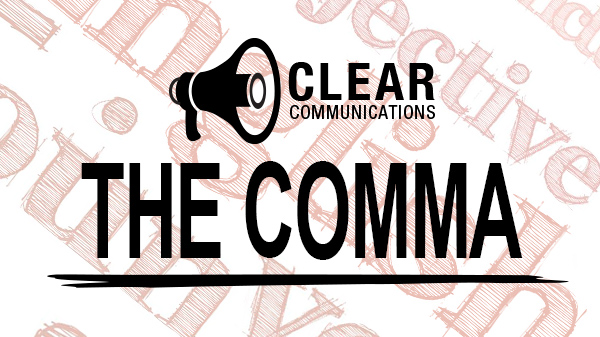Origin: a Latin derivative
meaning "Gift of the Earth."
Clear Communications: The Comma

Historically, the comma told an actor when to pause to take a breath. Today, the comma is still basically used when you want the reader to pause, but, unfortunately, it’s a little more complicated than that. Here are a few basic rules to understand about the comma:
Comma Rules
1. The Oxford comma
The serial or Oxford comma is that final comma that comes before the conjunction in a series:
While in Hawaii, I plan on surfing, snorkeling, and scuba diving.
People have different opinions about whether or not you should use the Oxford comma. Choose what you want to do and just make sure to be consistent.
2. When listing adjectives, swap out and or or for a comma:
He carefully climbed the creaky steps of the ancient, rustic house.
But don’t put a comma if the adjectives are not part of a list. A good rule of thumb to remember here is if you can add a “and” or “or” between the adjectives, add in a comma.
Yesterday I saw a majestic golden eagle.
The eagle is not both majestic and golden, instead it is a majestic golden eagle.
3. Complicated series, or series that already have a comma in them, should be separated out by semicolons.
He visited Roanoke, Virginia; Charleston, South Carolina; and Medford, Pennsylvania during his vacation.
4. Joining two complete sentences should be done with a comma and a coordinating conjunction (and, but, or, nor, for, so, yet, and while):
If you don’t want to use the conjunction, you can’t use just the comma (because then you’ll have a “comma splice” or “run-on sentence”), instead, use the semicolon:
The dog gnawed on its bone; the cat lapped the milk.
Not
The dog gnawed on its bone, the cat lapped the milk.
5. Use commas to separate different elements of a sentence.
When additional information is added to a sentence, enclose it in commas, but be aware of changing meaning when adding commas.
The people at the conference who were able to buy the rare collectible were very happy.
Versus
The people at the conference, who were able to buy the rare collectible, were very happy.
6. If the information inside the commas is necessary, don’t set it apart with commas.
If Bill has more than one daughter:
Bill’s daughter Anne was funny.
But if the information is not necessary, put commas around it. For example, if Bill only has one daughter:
Bill’s daughter, Anne, was funny.
7. Dependent clauses require a comma depending on where they fall in the sentence. If they fall before the main clause, they must be followed by a comma; if they fall after the main clause, no comma is needed:
If you agree to our conditions, we will accept the proposal.
We will accept the proposal if you agree to our conditions.
8. Interjections should be set apart by commas:
That, of course, was the proverbial straw for this camel’s back.
9. Tag questions should be separated by commas:
That’s Frank’s car, isn’t it?
10.Contrasting and opposing expressions should be set off by commas:
He changed his style, not his ethics.
11. Brackets and parentheses should be followed by commas:
After reviewing the document (and deciding for himself the true import of the message), the spy promptly slipped the letter into his pocket.
12. In the month-day-year style of dates, use commas to set off the year; in day-month-year, or when using only the month and year or a specific day with a year, no commas are necessary:
- December 7, 1941, is a day that shall live in infamy forever.
- Pearl Harbor was attacked on 7 December 1941.
- In March 2008 she turned 80.
- On Valentine’s Day 1929 Al Capone struck at his enemies.






